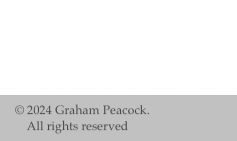|
Graham Peacock at Gallery One
Art in America. Dec. 2001 : pg. 126 by Ken Carpenter
For almost two decades Graham Peacock has been recognized as a leading Canadian painter and a central figure in the New New Painters, a widely exhibited group of Canadian and American artists engaged in an intense exploration of the creative potential of the newest acrylic paints. His exhibition at Gallery One demonstrated just how singular an artist he is and how ill suited conventional methods of formal analysis are to understanding his work.
Peacock identifies with what he calls "process painting" or "the fluid school" as exemplified by jackson Pollock and Morris Louis. Like them, he has invented his own way of working. Peacock pours layer uon layer of viscous acrylic, allowing the paint to flow freely, creating natural formations and fusing colors in lush, marbelized surfaces. The viewer might be reminded of great natural movements: the flow of glaciers, eddying rivers.
Since each layer of paint is poured before the previous layers have entirely dried, the surface crackles or "crazes" and so reveals its lower depths. The primary pictorial relation is no longer that of various elements to the picture plane but rather of one partially revealed surface to another. There are also powerful tensions between conflicting flows that carry along bits of plastic and glass.
Peacock has cropped and stretched these canvases in irregular, undulating shapes. Using pipe insulation, carpet padding and polyurethane fill, he has raised ridges and mounds within his paint surfaces. The utter materiality of these works might seem to bring his painting closer to sculpture, in a kind of Andersstreben, a striving after otherness, such as Walter Pater said could occasionally bring the strength of one art form to another. But rather than sculptural, these paintings might be called topographical. They are in accord with MirÃÑ's ambition to "remain within pure painting" while "at the same time going beyond it."
Peacock aligns his art with the pleasure principle and is determined that it should be positive, convey joy. That it does, although one wonders if this strong work might not be even stronger if freed from that confining ambition.
|
|
|



